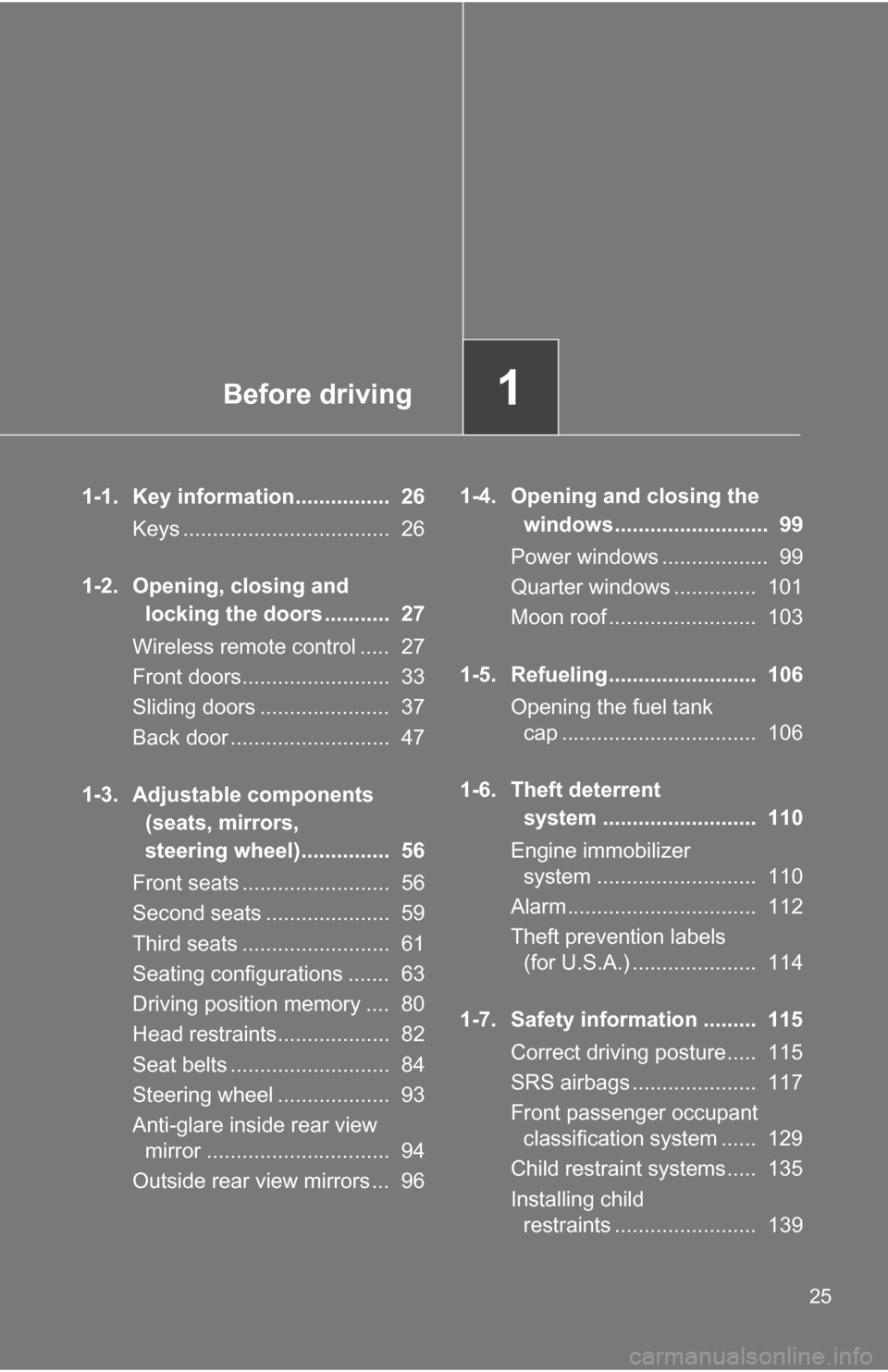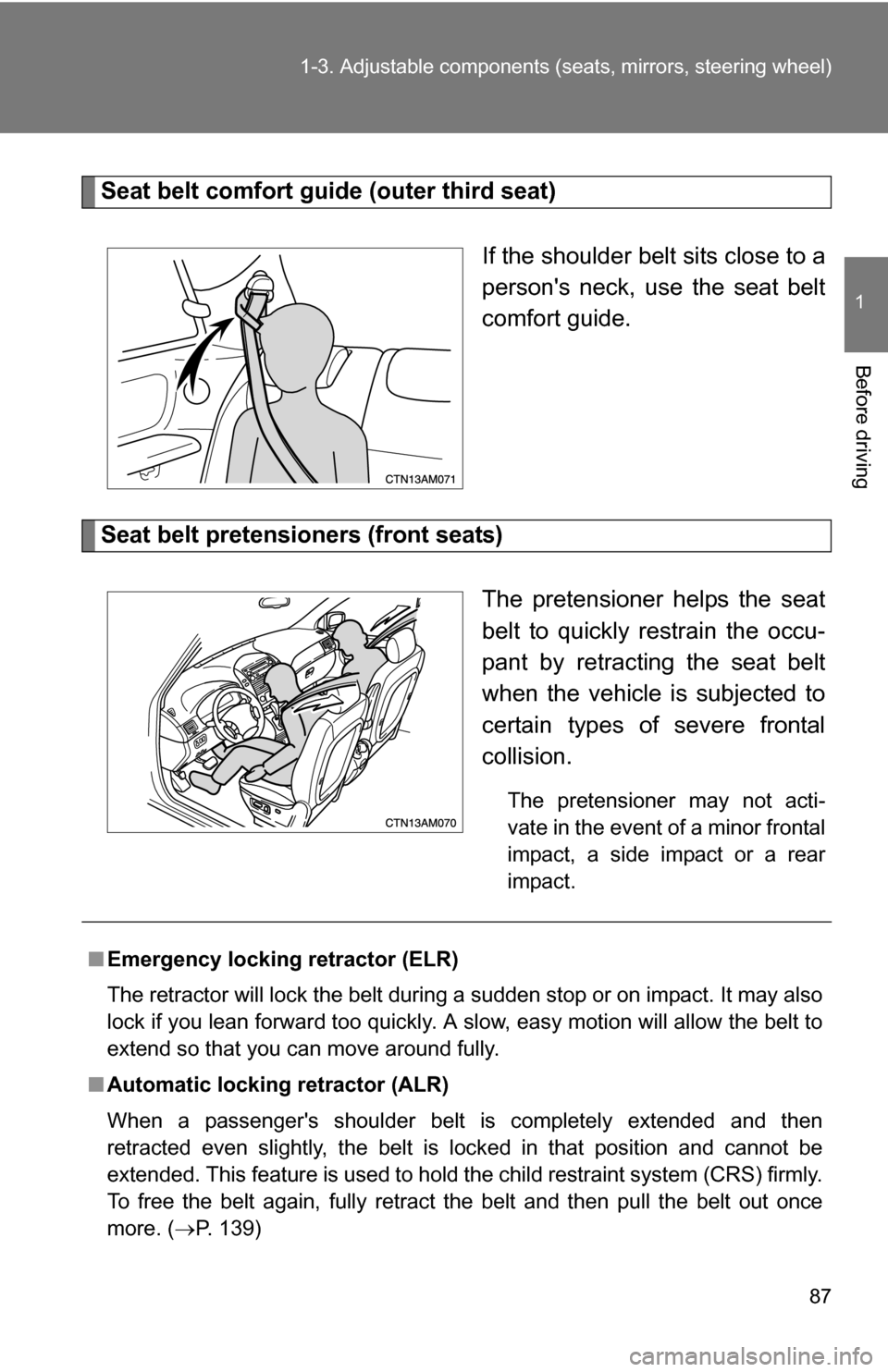Page 2 of 592

TABLE OF CONTENTSIndex
2
1-1. Key information .................. 26Keys ..................................... 26
1-2. Opening, closing and
locking the doors ............. 27
Wireless remote control ....... 27
Front doors ........................... 33
Sliding doors ........................ 37
Back door ............................. 47
1-3. Adjustable components
(seats, mirrors,
steering wheel) ................. 56
Front seats ........................... 56
Second seats ....................... 59
Third seats ........................... 61
Seating configurations.......... 63
Driving position memory....... 80
Head restraints ..................... 82
Seat belts ............................. 84
Steering wheel ..................... 93
Anti-glare inside rear view mirror .................................. 94
Outside rear view mirrors ..... 96
1-4. Opening a nd closing the
window s ............................ 99
Power windows .................... 99
Quarter windows ................ 101
Moon roof ........................... 103
1-5. Refueling ........................... 106 Opening the fuel tank cap ................................... 106 1-6. Theft deterrent system ..... 110
Engine immobilizer system .............................. 110
Alarm .................................. 112
Theft prevention labels (for U.S.A.) ....................... 114
1-7. Safety information ............ 115 Correct driving posture ....... 115
SRS airbags ....................... 117
Front passenger occupant classification system ......... 129
Child restraint systems ....... 135
Installing child restraints ..... 139
2-1. Driving procedures........... 158 Driving the vehicle .............. 158
Engine (ignition) switch....... 167
Automatic transmission ...... 170
Turn signal lever ................. 172
Parking brake ..................... 173
2-2. Instrument cl uster and
information display ........ 174
Gauges and meters ............ 174
Indicators and warning lights ................................. 177
Trip information display ...... 181
2-3. Operating the li ghts and
wipers .............................. 185
Headlight switch ................. 185
Fog light switch ................... 190
1Before driving
2When driving
Page 25 of 592

Before driving1
25
1-1. Key information................ 26Keys ................................... 26
1-2. Opening, closing and locking the doors ........... 27
Wireless remote control ..... 27
Front doors......................... 33
Sliding doors ...................... 37
Back door ........................... 47
1-3. Adjustable components (seats, mirrors,
steering wheel)............... 56
Front seats ......................... 56
Second seats ..................... 59
Third seats ......................... 61
Seating configurations ....... 63
Driving position memory .... 80
Head restraints................... 82
Seat belts ........................... 84
Steering wheel ................... 93
Anti-glare inside rear view mirror ............................... 94
Outside rear view mirrors ... 96 1-4. Opening and closing the
windows.......................... 99
Power windows .................. 99
Quarter windows .............. 101
Moon roof ......................... 103
1-5. Refueling......................... 106 Opening the fuel tank cap ................................. 106
1-6. Theft deterrent system .......................... 110
Engine immobilizer system ........................... 110
Alarm................................ 112
Theft prevention labels (for U.S.A.) ..................... 114
1-7. Safety information ......... 115 Correct driving posture..... 115
SRS airbags ..................... 117
Front passenger occupant classification system ...... 129
Child restraint systems..... 135
Installing child restraints ........................ 139
Page 39 of 592
39
1-2. Opening, closing and locking the doors
1
Before driving
Canceling the power slidi
ng door system (if equipped)
Turn the main switch off to dis-
able the power sliding door sys-
tem.Off
The sliding doors can be opened
and closed manually.
On
The power sliding door can be
opened and closed with the
power sliding door switches for
the front occupants or wireless
remote control even if the sliding
door child-protectors are locked.
Locking the sliding doors from the outside without the wireless remote control
Move the inside lock knob to the lock position.
Close the sliding door.
From rear seats
Push the switch to open and
close each sliding door.
STEP1
STEP2
Page 42 of 592
42 1-2. Opening, closing and locking the doors
CAUTION
■Caution while driving
Observe the following precautions while driving.
Failure to do so may cause a door to open unexpectedly and an occupant to
fall out of the vehicle, resulting in death or serious injury.
●Always use a seat belt.
● Always lock the doors.
● Ensure that all doors are properly closed.
● Do not slide the inside handle of the doors while driving.
● Set the sliding door child protector locks when children are seated in the
vehicle.
■ When children are in the vehicle
Observe the following precautions.
Failure to do so may result in death or serious injury.
●Do not leave children alone in the vehicle.
If a child is accidentally locked in the vehicle, they could overheat.
● Do not allow a child to open or close the sliding door.
Doing so may cause the sliding door to operate unexpectedly, or cause the
child’s hands, head, or neck to be caught by the closing sliding door.
Page 87 of 592

87
1-3. Adjustable components (s
eats, mirrors, steering wheel)
1
Before driving
Seat belt comfort guide (outer third seat)
If the shoulder belt sits close to a
person's neck, use the seat belt
comfort guide.
Seat belt pretensioners (front seats)
The pretensioner helps the seat
belt to quickly restrain the occu-
pant by retracting the seat belt
when the vehicle is subjected to
certain types of severe frontal
collision.
The pretensioner may not acti-
vate in the event of a minor frontal
impact, a side impact or a rear
impact.
■Emergency locking retractor (ELR)
The retractor will lock the belt during a sudden stop or on impact. It may also
lock if you lean forward too quickly. A slow, easy motion will allow the belt to
extend so that you can move around fully.
■ Automatic locking retractor (ALR)
When a passenger's shoulder belt is completely extended and then
retracted even slightly, the belt is locked in that position and cannot be
extended. This feature is used to hold the child restraint system (CRS) firmly.
To free the belt again, fully retract the belt and then pull the belt out once
more. ( P. 139)
Page 89 of 592
89
1-3. Adjustable components (s
eats, mirrors, steering wheel)
1
Before driving
■Child seat belt usage
The seat belts of your vehicle were principally designed for persons of adult
size.
●Use a child restraint system appropriate for the child, until the child
becomes large enough to properly wear the vehicle's seat belt. ( P. 135)
● When the child becomes large enough to properly wear the vehicle's seat
belt, follow the instructions on P. 84 regarding seat belt usage.
■ Replacing the belt after the pretensioner has been activated
If the vehicle is involved in multiple collisions, the pretensioner will activate
for the first collision, but will not activate for the second or subsequent colli-
sions.
■ Seat belt extender
If your seat belts cannot be fastened
securely because they are not long
enough, a personalized seat belt
extender is available from your Toyota
dealer free of charge.
Page 90 of 592

90 1-3. Adjustable components (seats, mirrors, steering wheel)
CAUTION
Observe the following precautions to reduce the risk of injury in the event of
sudden braking or an accident.
Failing to do so may cause death or severe injury.
■Wearing a seat belt
●Ensure that all passengers wear a seat belt.
● Always wear a seat belt properly.
● Each seat belt should be used by one person only. Do not use a seat belt
for more than one person at once, including children.
● Toyota recommends that children be seated in the rear seat and always
use a seat belt and/or an appropriate child restraint system.
● Do not recline the seat any more than necessary to achieve a proper seat-
ing position. The seat belt is most effective when the occupants are sitting
up straight and well back in the seats.
● Do not wear the shoulder belt under your arm.
● Always wear your seat belt low and snug across your hips.
● Always wear the belt with the shoulder portion over the outside armrest
and the lap portion under the outside armrest.
■ Seat belt pretensioners
●Do not place anything, such as a cushion, on the front passenger's seat.
Doing so will disperse the passenger's weight, which prevents the sensor
from detecting the passenger's weight properly. As a result, the seat belt
pretensioner for the front passenger's seat may not activate in the event of
a collision.
● If the pretensioner has activated, the seat belt becomes locked: it cannot
be further extended, nor will it return to the stowed position. The seat belt
cannot be used again and must be replaced at your Toyota dealer.
■ Child restraint lock function belt
Do not allow children to play with the child restraint lock function bel\
t.
Page 92 of 592
92 1-3. Adjustable components (seats, mirrors, steering wheel)
CAUTION
■Using a seat belt extender
●Do not wear the seat belt extender if you can fasten the seat belt without
the extender.
● Do not use the seat belt extender when installing a child restraint system
because the belt will not securely hold the child restraint system, increas-
ing the risk of death or injury in the event of a collision.
● The personalized extender may not be safe on another vehicle, when
used by another person, or at a different seating position other than the
one originally intended.
NOTICE
■When using a seat belt extender
When releasing the seat belt, press on the buckle release button on the
extender, not on the seat belt.
This helps prevent damage to the vehicle interior and the extender itself.